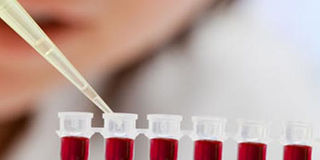What you did not know about DNA testing

A mother of five Thursday urged the High Court to order DNA testing to establish paternity in a case in which a 99-year-old man has stopped the burial of his “son” on his 60-acre farm. PHOTO|FILE
What you need to know:
The consolation, according to experts, is that the mutation happens only to one or several tissues and not the entire body. When a DNA parental testing presents a negative testing, for example, further tests could be done using samples from other tissues.
Dar es Salaam. Susan Mgaya cradles her baby tenderly, but she appears stressed. She quickly opens up when I get her talking, though. Her husband has rejected her one-year-old daughter, Sara, after a DNA test produced results showing that her husband was not the father. Susan claims she has known no other man during her marriage. She is now in a dilemma over what to do next.
There are thousands women in the same position. Five years ago, Esther Ndambo and Esther Sambila had babies on the same day at Bugando Medical Centre in Mwanza. They were then moved to the maternity ward while their babies were sent to a different ward. One of the babies died, setting the stage for a huge emotional fall-out. The following day, Ndambo was called in to breastfeed the baby who was still alive. On looking at the name tag, however, the nurse in charge discovered that the baby was Sambila’s. When Ndambo was told the baby was not hers, she refused to believe it and raised a furore. The police were called in and, after listening to both sides, decided that the two women should have a DNA test to determine the real mother.
The test has long been considered the most credible way to determine parentage. It is used to help solve crimes and it is also a tool for identifying missing people and the dead in mass accidents. But new findings have raised issues that could force biotechnologists and molecular biology experts to review the credibility of deoxyribonucleic acid (DNA) testing.
In the case of those fathers who reject their children even after DNA tests, the new findings may offer clues as to why the results were negative. DNA is a chemical found in the nucleus of every cell of living organisms and carries information that determines the make-up of a particular individual.
Testing for parental and other investigations has been based on the fact that DNA found in every tissue of the human body is the same regardless of where it is drawn--from blood, skin, saliva, semen to urine, hair, bones and nails. These are inherited from both parents at the time of fertilisation.
But, according to findings published in Science journal, DNA in body tissues can mutate (change of the DNA structure of a cell) in situations such as childbirth and deliver different results during testing.
Experts have moved fast to allay fears that the findings have dented the credibility of DNA, which remains the most credible mode of parental testing because not all cells in a human body can mutate. This finding only calls for more care and repeated tests using cells from multiple organs to affirm the accuracy of DNA testing, they say.
Prof Mugassa Rubindamayugi of the University of Dar es Salaam agrees that the findings are correct but they change little in the understanding of DNA testing and results. Prof Rubindamayugi, who heads the department of molecular biology and biotechnology, told The Citizen: “Mutation of cells in one of the tissues in a human body is well known. It could be caused by things like the use of mobile phones. This has been the cause of increasing cancer and diabetes cases. But it does not significantly change what we know on DNA testing.”
The consolation, according to experts, is that the mutation happens only to one or several tissues and not the entire body. When a DNA parental testing presents a negative testing, for example, further tests could be done using samples from other tissues.
Gloria Machuve, who heads the DNA, criminal cases and biology department at the Chief Government Chemist’s office, says you may also have more than one set of DNA when you have had an organ transplant or In Vitro Fertilisation (IVF).
When you go through any transplant process, the new organ may cause cell division and some of the cells from the organ transplanted may get into the bloodstream.
When a person has more than one gene, this is called mosaicism. Says Ms Machuve: “Remember that the organ transplanted is from another person who has his or her own genes. When that organ is transplanted, the cells may enter his or her bloodstream and he/she may have two different sets of DNA.”
But Dr Henry Mwakyoma, a senior pathologist at Muhimbili National Hospital, argues that it is not possible for one person to have more than one set of DNA. Twins can acquire different kinds of cells during the ovulation process, though.
IVF also makes it possible for sperms to break down their cells, upon which those cells may enter a mother’s bloodstream and provide her with different genes.
A DNA test is usually done by taking samples from blood, saliva, sperm and vaginal fluid, hair or nails. In a controversial case, Antonio Moreli of Australia had a sperm DNA sample that did not match the weapon he allegedly used in a crime. But the fingerprint DNA was the same as the sample from his skin.
According to Ms Machuve, the Government Chemist can provide the test in crime cases. It is the last thing done after all the evidence has been taken.




